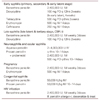References
1. Sanchez MR. In : Wolff K, Goldsmith LA, Katz SI, Gilchrest BA, Paller AS, Leffell DJ, eds. Syphilis. Fitzpatrick's dermatology in general medicine 2008. 7th edth ed. New york: McGraw-Hill; 1955–1977.
2. Willcox RR. A World wide view of venereal disease. Br J Vener Dis 1972. 48163–176.
3. Chen Z, Zhang G, Gong X. Syphilis returns to China: results of the national surveillance program from the Chinese Center for STD Control, Nanjing, China. Lancet 2007. 369132–138.
4. Lautenschlager S. Diagnosis of Syphilis: Clinical and laboratory problems. J Dtsch Dermatol Ges 2006. 121058–1072.
5. Nicoll A, Harmers FE. Are trends in HIV, gonorrhea, and syphilis worsening in Western Europe? BMG 2002. 3241324–1327.
6. Lin CC, Gao X, Chen XS, Chen Q, Cohen MS. China's Syphilis Epidemic: A Systemic Review of Seroprevalence Studies. Sex Transm Dis 2006. 33726–736.
7. Chun IK, Shon HS, Kim YP. Clinical Observation of Syphilis during Ten Consecutive Years (1968~1977). Korean J Dermatol 1979. 1717–27.
8. Goh BT. Syphilis in adults. Sex Transm Infect 2005. 81448–452.
9. Comparison of early and late latent syphilis-Colorado, 1991. MMWR Morb Mortal Wkly Rep 1993. 42155–157.
10. Lynn WA, Lightman S. Syphilis and HIV: a dangerous combination. Lancet Infect Dis 2004. 4456–466.
11. Zetola NM, Klausner JD. Syphilis and HIV infection: an update. Clin Infect Dis 2007. 441222–1228.
12. Kim HS, Lee HS, Lee MG, Lee JB. Recent Trends of Syphilis Prevalence in the Normal Population in Korea - 1995. Korean J Dermatol 1997. 35514–519.
13. Choi YS, Yu HJ, Son SJ. Prevalence of Syphilis in Normal Population in Korea (1987-1991). Korean J Dermatol 1994. 32866–871.
14. Shin BS, Song JY, Chung BS, Choi KC. A clinical study of case of syphilis referred to our dermatologic clinic(2002~2007). Korean J Dermatol 2008. 461179–1185.
15. Park HJ. Clinical observation and statistical consideration of syphilis(2000-2007). Korean J Dermatol 2008. 461344–1352.
16. Korea Centers for Disease Control and Prevention. Disease web statistics system 2003~2008.
17. Lee SH, Suh DH, Cho KH, Eun HC. Two cases of unusual man-ifestations of secondary syphilis accompanied by human immunodeficiency virus infection. Korean J Dermatol 2004. 41354–359.
18. Kang SK, Kim ES, Lee MW, Choi JH, Sung KJ, Moon KC. Two cases of secondary syphilis accompanied by acquired immunodeficiency syndrome. Korean J Dermatol 2002. 40428–432.
19. French P, Gomberg M, Janier M, Schmidt B, van Voorst Vader P, Young H. IUSTI: 2008 European Guidelines on the Management of Syphilis. Int J STD AIDS 2009. 20300–309.
20. Kingston M, French P, Goh B, Goold P, Higgins S, Sukthankar A, Stott C, Turner A, Tyler C, Young H. UK National Guidelines on the Management of Syphilis 2008. Int J STD AIDS 2008. 19729–740.
21. Kim JY, Kim WH, Cho CH, Kim GY, Nam MH, Kim JS, Bae SY, Cho YJ. Evaluation of automated architect syphilis TP as a diagnostic laboratory screening test for syphilis. Korean J Lab Med 2008. 28475–482.
22. Huh HJ, Lee KK, Kim ES, Chae SL. Analysis of positive result in mediace rapid plasma reagin and treponema pallidum latex agglutinination as the automated syphilis test. Korean J Lab Med 2007. 27324–329.
23. Harris JRW. The control of venereal disease. Brit J Vener Dis 1975. 51285–288.

